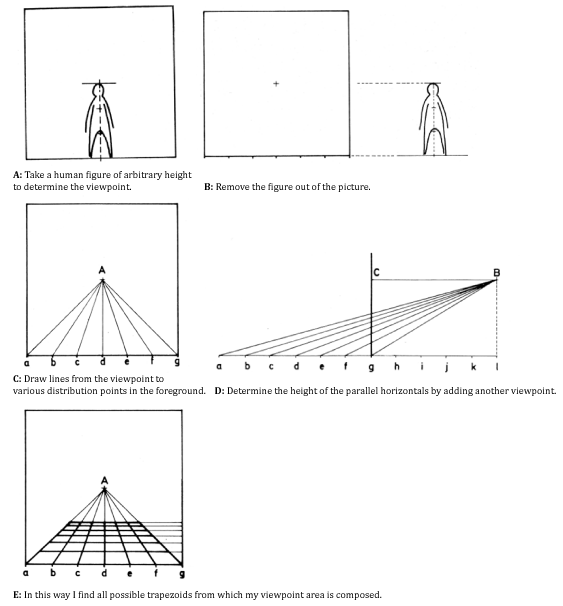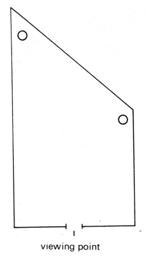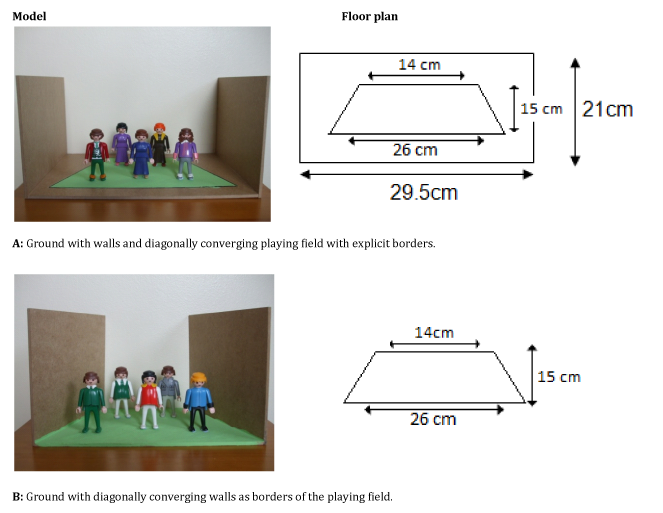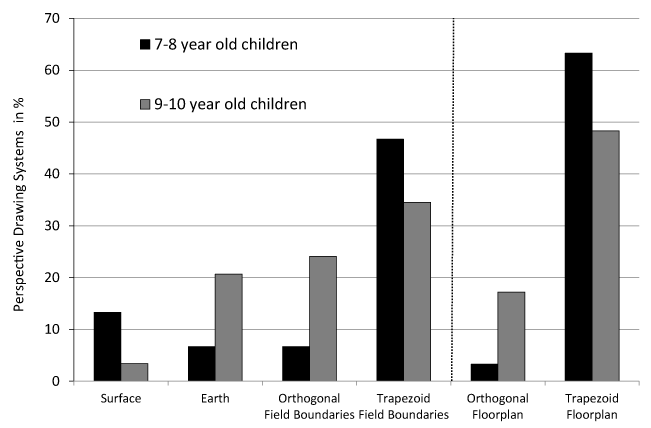Advances in
eISSN: 2377-4290


Children can draw visually realistic objects if they know how to focus on the embedded object contour as shown by the Embedded Figure Test.1−3 However, an object contour is not a useful visual cue for drawing in perspective. Even at age eleven, only a minority of children draw in perspective.4 The current brief review shows what kind of stimulus model is needed to elicit a perspective drawing much earlier than after a protracted stage-wise development. It is demonstrated that when perspective is embodied in the spatial model itself, and object-and view-specificity are in agreement, visual awareness is not required in order to be able to draw in perspective. It is concluded that early perspective mapping can be carried out by normally developing, and not just by highly practised talented or autistic children.
Keywords: view-specificity, object-specificity, size modification, perspective mapping, sketching vs. construction, geometry, visual awareness, spatial axes systems
PPA, parahippocampal place area; RSC, retrosplenial cortex; ASD, autistic spectrum disorder; HF, high functioning
The focus of this brief review is about the origins of being able to draw in perspective. This is a topic for artists as well as for neuroscientists, but the current brief review describes, explains and discusses the awareness and representation of perspective as a research question of experiments within Developmental Psychology, that is research with normally developing (neurotypical) infants and children of different age groups. Already infants are able to see in perspective from about the age of four to five months5 and from about six months, they are able to pick up depth cues from pictures.6 Young children start drawing objects between three and four years7 which they find important. These early drawings show schematic objects floating in pictorial space and only gradually are the spatial context explicitly conceptualized in several spatial systems until perspective is drawn at about age ten to eleven by some children.8 Drawing in perspective, and identifying different perspectives of the same array is seen as difficult and as a late acquisition.9 Many adults still are not able to draw precisely what they see.10
The current review shows how these spatial systems develop in relation to the figure drawings which are mastered much earlier, but also how young children can skip all these stages and sketch in perspective if the model itself embodies perspective. Initially, I will explain historic instructions on how to construct perspective drawings that remove the figure out of the picture and focus only on the spatial axes system instead. Second, I will explain the figure size illusions in the Ames room that has a ground plan with a diagonal unbeknown to the viewers. I am going to explain how children learn to adapt figure size to spatial systems and their discovery of spatial boundaries and spatial constraints of spatial systems. Crucially, in my most recent study, the 3D models have built-in perspective like the Ames room which led to perspective mapping in a sketch, rather than in a graphic construction that relies on geometrical knowledge. The conclusion here is that drawing an optical impression can rely on early layers of ability not only in talented or autistic children11−14 but also in typically developing children.
Children can draw visually realistic objects if they know how to focus on just the embedded object contour.1−3 Especially boys focus on the contour of figure silhouette.3,15 However, an object contour is not a useful visual cue for drawing in perspective. The current brief review will show what kind of stimulus model is needed to elicit a perspective drawing earlier than after a protracted stage-wise development.4 There are two ways of drawing in perspective. One way is to draw in perspective without a model that is 'drawing from memory'. The second way of drawing in perspective is drawing from a 'live' model that is the draughtsman is positioned in front of e.g. a landscape, a marketplace, or a still life. Both ways of drawing in perspective were explained already in the 15th century. These early instructions are psychologically interesting because in both cases they involve the removal resp. the distancing from the figurative model.16
One of the earliest instructions about perspective drawing without a model is by Alberti in 1435 where he describes twelve different steps; see an abbreviated version in Figure 1.17 Alberti advises to take a human figure of arbitrary height and determine the viewpoint (Figure 1A). So in this way the viewpoint will be on a human scale. He then instructs to remove the figure out of the picture and you are just left with the viewpoint as such (Figure 1B). Now you should draw the lines from the viewpoint onto the ground floor on the lower rim of the picture (Figure 1C). In order to draw the spatial boundaries of areas in the simulated three-dimensional space, you need a second viewpoint outside your spatial system which determines the height of the interval of these areas in a visually realistic way (Figure 1D). Then draw parallel horizontal lines originating from the vertical cutting points of the external viewpoint axes (Figure 1E). As visible in Figure 1, the result is a trapezoid area composed of many smaller trapezoids which gives the illusion of depth and we call this perspective (Figure 2).

Figure 1 Construction of a perspective trapezoid area for human figures by Alberti's treatise with the title Della Pittura (1970, pp. 78, shortened and modified version of 12 steps, cited from Abels, p. 98,17 with friendly permission of Campus publishers, translation by the author).

Figure 2 The German painter Durer visited the Italian artists and constructed a mechanical device to shortcut the geometric computation (cited from Abels,17 p. 173, with friendly permission of Campus publishers). (A) Note that the device could be an empty frame on which to directly trace the contours. (B) A frame with a grid where each segment could be mapped onto the corresponding grid on the page.
Now, what do you do if you have a real model that you want to draw in perspective? The problem is one cannot use Alberti's instructions because you cannot remove the figure. The Renaissance artists would install a frame between the figure and themselves. In this way, they have built a 'pure' ready-made spatial system, but one which is transparent and allows a view onto a figure. They can now either draw on the frame itself, or if the spatial frame has a grid it is possible to map the content from each square of the grid onto their drawing surface and obtain perspective in a cumulative way. Also children can draw the depth of two overlapping spheres when such a frame was used.18 We can conclude from these instructions that there is an intricate relationship between the figure and the space system and that it is helpful if the figure is removed from the space system so that the space system as such can be appreciated. This intricate relationship between the space system and figure size is even more compellingly demonstrated by the psychologist who devised the Ames room.19 The Ames room is an ordinary room but with an extraordinary floor plan. The floor plan has a diagonal so that one side of the room is longer than the other (Figure 3), right. The viewers are not aware of the changed floor plan because they look into the room through a peephole. The viewers see this room as normal because they cannot imagine any other kind of room and they do not know the floor plan, but what happens to them is that the perception of the figure size is distorted instead: The size is either very small or superhuman large, (Figure 3), left.20


This principle of figure size modification and a spatial system with diagonals was exploited in studies about adapting size in 2-dimensional space systems.8,21,22 Children do not draw any perspective straightaway. In fact, most children do not do draw any perspective at all. For instance, in a sample of N=142 children, only 1.41% of the 9-year-old children and 8.45% of the 12-year-olds spontaneously drew in perspective21 (Table 1). So what do they do instead? Children have a number of spatial systems into which they draw figures. They usually start off drawing just objects and figures just into empty pictorial space; only thereafter do they begin to structure space with horizontal ground line where sometimes a skyline is added.23 Often children add the sun into one corner so that their drawing resembles what they know about the earth.24 Thereafter children start to draw areas, for instance an orthogonal football field. When this area is drawn as a trapezoid with diagonals, this view-specific space resembles perspective.
Because children do not draw these diagonal perspective space systems spontaneously, we drew all these spatial systems for them on the drawing paper with black lines and just asked them to draw five figures into each of the systems [8, N=297, 7-, 9-, 11- and 17-year-olds, 22, Study 2, N=170, 7-, 9- and 11-year-olds]. We presented children with these systems either in a logical sequence the way explained above, or in a random sequence, or we asked them in a control/practice condition to draw five figures into empty space. The 7-year-olds draw a rather small bandwidth of figure size, and they are only diminishing the figure size in the logical condition where the child's perception is gradually drawn into the third dimension. This is not the case anymore in 9-year-old children. They draw a diminished figure size in both the logical and the random sequence. But they discovered that if there are no spatial constraints and no boundaries that they can expand figure size. So at age 9 they continuously draw a larger figure size in the practice condition where there are no spatial constraints. Also the 11-year-olds draw very large when they can expand in an empty space, but they draw also really small in the more constrained area and perspective spatial systems. Seventeen-year-olds do not expand anymore, but they still diminish the figure. These are of course averaged values over hundreds of children. There are individual children like the bird view drawers who draw miniature figures in top-down views in their football field drawings who show an excellent ability to flexibly increase foreground figure size again in the perspective system. However, there are also some 11-year-olds who do not shrink figure size at all and whose figures are not in proportion to their context.
In the next experiment, instead of drawing these spatial systems directly and ready-made on children's drawing paper, they were built as small spaces in three dimensions like architectural models. Illustrations of all these models are available in the original research publication [4, N=59], but the two perspective models are included here for illustration in Figure 4. The first model was a just a green platform as a model for the empty space. Of course it is not possible to have objects floating in space; hence just a simple base was used. The second model is the earth model which is an extension of the platform. The green floor is now complemented with a light blue lid which represents the skyline. The next model represents the space system which has areas. The model is the same as the earth model but without the lid. This model is given in two versions, one in which a playing field with spatial boundaries is drawn, but the overall area is the same. Children can either respect these boundaries when drawing the five figures, or not. The control model has just the playing field without the surround, so the total area is actually smaller, but children still have the same sized paper to draw on. This control model shows whether children would draw smaller just because of the new spatial boundaries. The crucial fourth model is the perspective model where the playing field is drawn as a trapezoid like in Alberti's instruction on how to draw in perspective (Figure 4).25

Figure 4 Perspective systems. This spatial model is the same as the orthogonal model except that the angles of the playing field are 70o and 110 o rather than 90o. In this way, the diagonals of the perspective models were strongly converging and directly perceptible,25 because they were properties of the array. In (Model 4A), the model had the measurements of an A4 sheet, with a trapezoid playing field inserted. In (Model 4B), this very playing field had the identical extensions, covered the entire surface and had no surrounding area.4
Importantly, in the control model, if you omit the surround, the whole floor has a trapezoid shape, that is, perspective is not just a painted area, but it is the floor, a property of the spatial model itself, embodied perspective. In terms of figure size reduction, the 7-year-olds show the steepest reduction, the 8-year-olds show some sort of habitual size and the 9- and 10-year-olds show a more gradual and subtle size reduction. Size reduction was significant only when spatial boundaries were present, that is in the models with the surround. Thus, the 3D models worked quite well but what was much more striking is the following almost sensational finding. Figure 5 shows that the 9- to 10-year-old children draw the more perspective drawings, the more advanced the 3D model. In contrast, as predicted the 7- to 8-year-old children very rarely draw in perspective, except some children when sitting in front of the surface model which allows a non-restricted view on a green area. However, this is considerably surpassed by another finding which is much more substantial in terms of frequencies. Nearly half of the 7- to 8-year-olds draw in perspective and more often than the 9- to 10-year-old children when they are placed in front of the model with the trapezoid playing field area. Nearly two thirds of the 7- to 8-year-olds draw in perspective and more often than the 9- to 10-year-old children when they are placed in front of the model with the trapezoid ground floor plan which amounts to a replication within the study. This is a completely new finding and contradicts all previous results which show a very protracted developmental pathway for drawing in perspective.26

Figure 5 Percentage of perspective drawing systems when using six different 3D spatial models.4
Again, illustrations of drawings by individual children within the original research paper show some interesting variations. Some 7-year-old children are drawing the floor plan with a diagonal and then stick in their figures which they draw at the habitual size that they usually draw. But other 7-year-olds are drawing diagonal floor plans, also in reversed perspective, and these children are drawing fully developed three-dimensional spaces. They are producing 3D sketches of the entire model which is what you want to see when somebody is trying to depict what they see. So in summary, this brief review showed that
The impact of the model with the trapezoid floor plan becomes especially obvious when compared with the model that has an orthogonal floor plan as these models were identical except for their angularity. Seven-year-old children are not usually aware that they look at the world like a camera (which is in fact built following our knowledge about the visual system) although they may be aware of some depth features, e.g. that the size of an object will be smaller the further away27 or that lines of sight should be straight.28 However, so far it has not been shown that children at age seven know that spatial axes will converge towards the viewpoint.26 Instead, children at this age think more about object identity and less about appearances.2,15,29,30 Hence, it is concluded that the perspective model with the built-in perspective fits with children's belief that a picture should represent enduring properties of this world and not just an incidental subjective view such that perspective affords. Thus, the explanation of these new results would be that 7-year-old children were drawing in perspective because the current perspective model is a very special case of complete agreement between object-specificity and view-specificity. It has perspective built-in as a property. It will be interesting to conduct follow-up research to this study, for instance, by asking children to draw visual scenarios from virtual reality presented on a pc, laptop or tablet which would allow for more than one view into a room.
This early ability to draw in perspective is not yet perfect, and needs more control. While the drawings are clearly in three dimensions with converging diagonals, they are sketched (mapped) from visual input and are not constructed according to geometric principles. We thus cannot be sure that these visual images are represented in the brain as memories of how perspective looks like. However, we have ideas of how spatial context should look like, for instance, the right spatial context of objects can be spotted in a single glance (e.g. sink-kitchen vs. sink-living room).31 These object-place bindings are processed in the parahippocampal place area (PPA) and retrosplenial cortex (RSC).32 Object features such as size are processed in the occipital cortex, while only the type of space (interior vs. outdoor scenes) activates the PPA.33. In another experiment of this group, participants were presented with two types of spatial axes systems, a horizontal axes system, a closed diagonal perspective system, and a space with no axes systems. Interestingly, the presence of a spatial axes system depressed the object-related activity in the occipital cortex,34 confirming earlier research.35
Why are these neuroscience results mentioned? The reader may wonder whether the perspective drawings could be used to monitor the effect of the pharmacological treatment of high-functioning (HF) children with autistic spectrum disorder (ASD), comparable to the use of drawing the Rey-Osterrieth Figure in neuropsychological assessment.36−38 For instance, young children below the age of 5 have been successfully treated with a 50% success rate with Prozac.39 Very recently it has been shown that the surplus of neurons in the temporal lobe40 may be treatable with the mTOR inhibitor Rapamycin41 which increases curiosity towards social novelty. However, HF children with ASD are likely to draw better in three dimensions.42 Furthermore, HF adults with ASD often draw patterns where objects and figures are dissolved43 rather than integrated into a spatial context. This is backed up by eye-tracker studies which show aesthetic rather than social visual attention in relation to visual media.44 Also boys focus more on the silhouette rather than on the (social details) when drawing a human figure Thus, given that it was explained that perspective requires distancing from objects, that spatial axes systems depress brain activation towards objects, and that children and adults with ASD are performing well with regards to depth cues, it is unlikely that perspective drawing will be a good indicator for progress towards more interest in social interaction. To conclude this section on a more optimistic note, it would rather be predicted that children with ASD will indicate their heightened social interest when drawing novel attractive and desirable or only silly single objects with a clear outline and attractive colouring like in the drawing books of their same age peers.
In short, the brief review shows that perspective drawing is an interesting research area because it can be carried out in two different ways, mapping (sketching) versus conceptual construction. A special case was presented where object-specificity and view-specificity was identical which allowed children draw in perspective years ahead and in greater numbers. The development from a sketch towards a detailed and precise technical drawing is not yet known, and future research will show whether the early ability to sketch a concept such as perspective will help scientific and technical understanding and innovation.
None.
Author declares that there is no conflict of interest.

© . This is an open access article distributed under the terms of the, which permits unrestricted use, distribution, and build upon your work non-commercially.